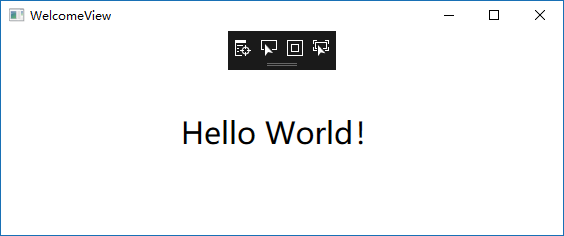MVVM Light 新手入門(2) :ViewModel / Model 中定義屬性 ,並在View中呼叫 利刃 MVVMLight
今天學習MVVM架構中“屬性”的新增並呼叫,特記錄如下,學習資料均來自於網路,特別感謝翁智華的利刃 MVVMLight系列。
一個視窗的基本模型如下:
View(檢視) -> ViewModel (檢視模型)-> 多個Model(模型)
注:
- 檢視是使用者在螢幕上看到的結構、佈局和外觀(UI)
- 檢視模型是暴露公共屬性和命令的檢視的抽象。在檢視模型中,繫結器在檢視和資料繫結器之間進行通訊。
- 模型是指代表真實狀態內容的領域模型(面向物件),或指代表內容的資料訪問層(以資料為中心)。
下面開始學習最基礎的寫法
1、新建一個Model
public class WelcomeModel : ObservableObject { private String introduction; /// <summary> /// 歡迎詞 /// </summary> public String Introduction { get { return introduction; } set { introduction = value; RaisePropertyChanged(() =>Introduction); } } }
- 這個Model繼承了一個父類:ObservableObject,這個父類的作用就是保證能夠檢測屬性是否被改變。它實現了INotifyPropertyChanged介面,通過觸發PropertyChanged事件達到通知UI更改的目的;
- 實體裡面定義的每個屬性都加上RaisePropertyChanged(PropertyName)的呼叫,就可以實現對UI的互動更新了。
public class WelcomeViewModel : ViewModelBase {類包含了一個命名為Welcome的WelcomeModel屬性,繼承了ViewBaseModel父類,繼承了ViewBaseModel父類,ViewBaseModel同時繼承 ObservableObject類和ICleanup介面。所以他同樣有INotifyPropertyChanged介面的能力,能夠通過觸發PropertyChanged事件達到通知View的目的; 3、寫一個View,來顯示和互動ViewModel。/// <summary> /// 建構函式 /// </summary> public WelcomeViewModel() { Welcome = new WelcomeModel() { Introduction = "Hello World!" }; } #region 屬性 private WelcomeModel welcome; /// <summary> /// 歡迎詞屬性 /// </summary> public WelcomeModel Welcome { get { return welcome; } set { welcome = value; RaisePropertyChanged(() => Welcome); } } #endregion }
<Window x:Class="Pvd.View.WelcomeView" xmlns="http://schemas.microsoft.com/winfx/2006/xaml/presentation" xmlns:d="http://schemas.microsoft.com/expression/blend/2008" xmlns:x="http://schemas.microsoft.com/winfx/2006/xaml" xmlns:mc="http://schemas.openxmlformats.org/markup-compatibility/2006" mc:Ignorable="d" Title="WelcomeView" Height="450" Width="800"> <Grid> <StackPanel VerticalAlignment="Center" HorizontalAlignment="Center" > <TextBlock Text="{Binding Welcome.Introduction}" FontSize="30" ></TextBlock> </StackPanel> </Grid> </Window>
TextBlock 綁定了 Welcome.Introduction,所以應該顯示Welcome物件下的Introduction屬性。
這時候的ViewModel和View是沒有任何關係的,所以我們在code-Behind的建構函式中寫上如下程式碼:
using Pvd.ViewModel; using System.Windows; namespace Pvd.View { /// <summary> /// WelcomeView.xaml 的互動邏輯 /// </summary> public partial class WelcomeView : Window { public WelcomeView() { InitializeComponent(); this.DataContext = new WelcomeViewModel(); } } }
把 WelcomeViewModel 賦值給當前檢視的資料上下文。所以可以在當前檢視中使用ViewModel中所有的公開屬性和命令。
執行結果正常

總結:
1、通過 this.DataContext = new WelcomeViewModel(); 把 View 和 ViewModel 繫結。繫結後,可以直接在View中呼叫 ViewModel中公開的屬性和命令
2、所有的VideModel 都需要繼承於:ViewModelBase
3、所有的Model都繼承於ObservableObject
4、定義屬性方法如下,並在每個屬性中都加上RaisePropertyChanged(PropertyName)的呼叫,就可以實現對UI的互動更新了。
private String ~introduction;
public String Introduction
{
get { return ~introduction; }
set { ~introduction= value; RaisePropertyChanged(() => Introduction); }
}
新手入門,理解上有偏差,請各位老師提寶貴意見。
下一篇博文我將學習如何在MVVM架構中新增並呼叫方法。
